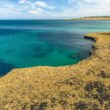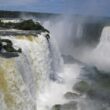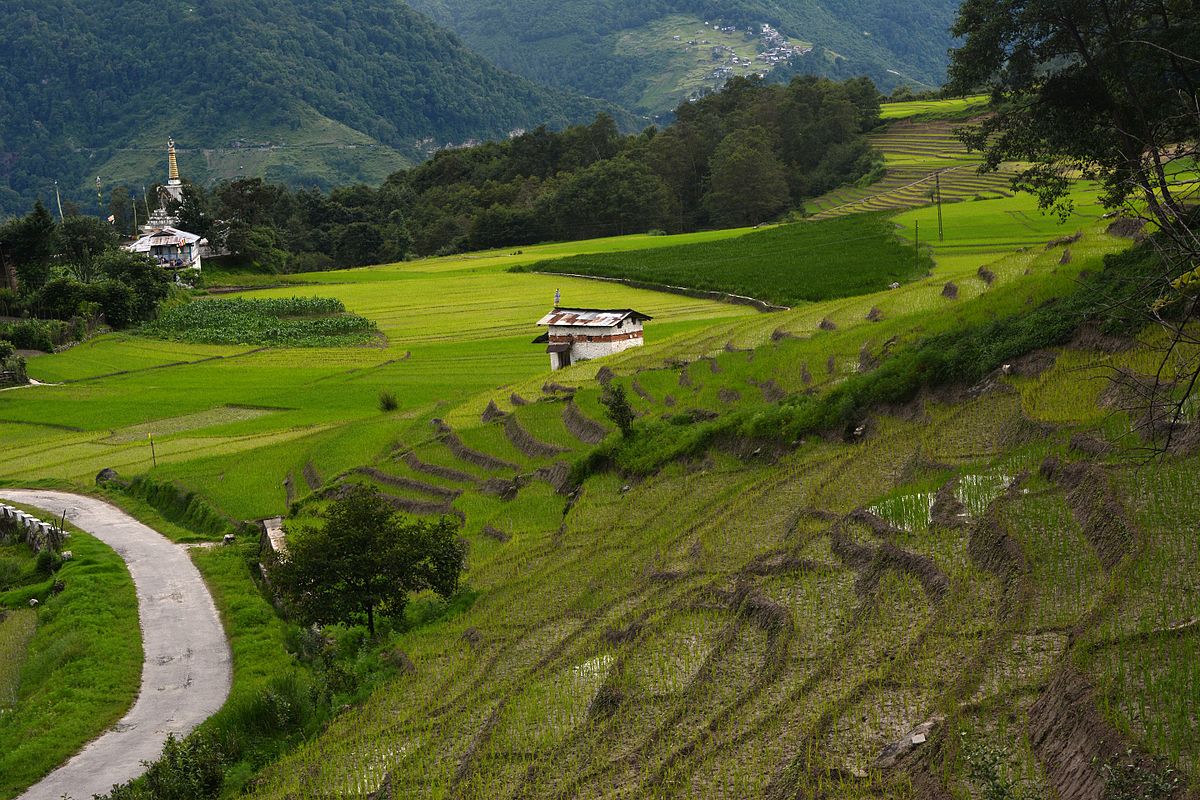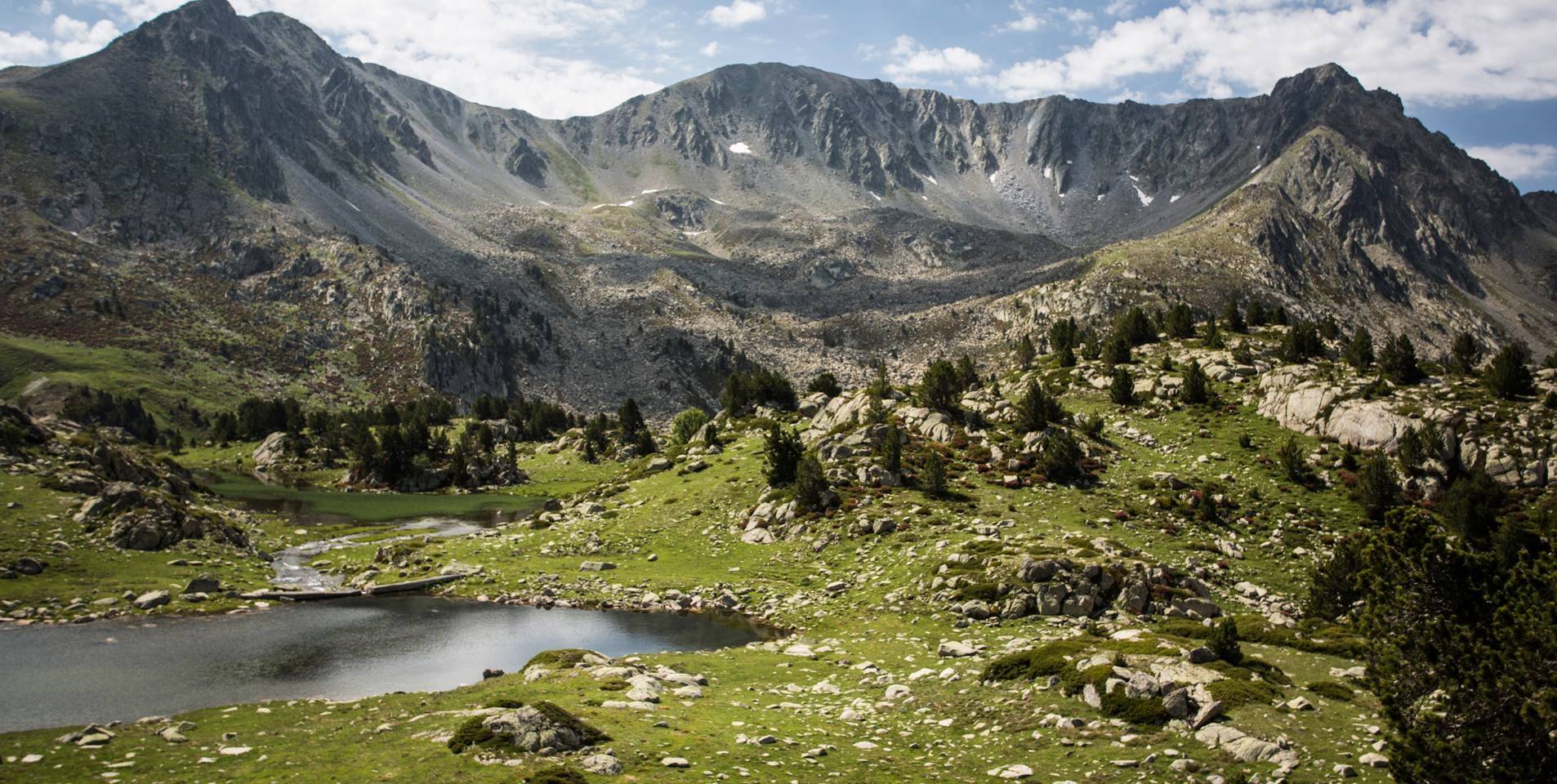Enriched with pristine rainforests, waterfalls, and limestone caves, Kanchanaburi is a popular resort town located at the confluence of the Khwa Noi and Khwa Yai rivers in western Thailand. Considered the microcosm of Thailand, Kanchanaburi, and its surroundings are home to stylish resorts, beautiful reservoirs, pagodas, historical sites, trekking, golfing, and white-water rafting destinations. Located just 2 hours away from Bangkok, the city is mainly accessible by roadways and trains, the latter being more common.
Kanchanaburi attracts a lot of backpackers and those interested in Thailand’s gruesome history of World War II. Kanchanaburi’s WWII-era Burma Railway, built by prisoners of war, was immortalized in the film ‘The Bridge on the River Kwai’. The bridge, and railway line, along with other war relic historical sites and museums, stand as evidence of this quiet city’s past.
As mentioned earlier, Kanchanaburi is blessed with untouched flora and fauna. Erawan National Park is a delightful contrast to the city’s World War I relic experience. The park includes tropical forests, gibbons, cobras, and elephants, aqua-colored seven-tiered waterfalls for swimming, and the extensive Tham Phra That cave system. Travelers especially go on hiking tours within the lush green vegetation or nearby villages.
While Kanchanaburi was primarily a backpacker’s haven, over the years, a number of affluent resorts and hotels have swung into business, offering a more modern living experience without taking away from the old-world charm of the city and its surrounding areas. We do. For those who wish to experience a bucolic Thailand and immerse themselves in a historical journey, this serene city is much more than ideal.
Things To Do In Kanchanaburi
- Bridge On The River Kwai
Recommended for all history lovers, the Death Railway Bridge was brought to Kanchanaburi by the Japanese during World War II. It was originally made in Java and then assembled by prisoners of war in Kanchanaburi. It was provided as a link between Thailand and Burma. Thousands of people were killed during the construction, and therefore today many travelers visit this place to pay tribute.
- Elephantsworld Kanchanaburi
Elephant World is a non-profit organization that is very different from normal animal camps. Here, they shelter sick, old, or abused elephants that have previously been used for recreation. When you come here, instead of riding on elephants like in some animal centers, you bathe the elephants, feed them, prepare their lunch, and make sure they have a good and satisfying time. A one-day trip to Elephant World includes a Thai buffet lunch and pickup service. Money goes to take care of elephants in this wonderful NGO.
- Kanchanaburi War Cemetery
Designed by Colin St. Clair Oaks and maintained by the Commonwealth War Graves Commission (CWGC), Kanchanaburi War Cemetery is the larger of Kanchanaburi’s two war cemeteries and is adjacent to Seung Chuto Road, the main road through Kanchanaburi town. Of the 6,982 prisoners of war (PoWs) buried here, nearly half were British; The rest came mainly from Australia and the Netherlands. Remains of American POWs were sent home. The place also records the names of 11 men from the army of undivided India who was buried in Muslim cemeteries.
This allied war cemetery houses the graves of not only prisoners of war but also local workers and other soldiers who died during the construction of the Death Railway. One of the main reasons for so many deaths was the brutality of the Japanese and Korean guards. The planks on the tombs are of great importance.
- Erawan National Park
It is the national park of the highest waterfall in Thailand and resembles the three-headed elephant, Erawan. The Erawan National Park, named after the white three-headed elephant from Hindu mythology, is a short distance from the Kanchanaburi center. It is a beautiful forest with 7 layers of waterfalls, bridges, and many rocks. Many of the waterfalls have calm and serene pools where you can enjoy swimming. This serene retreat should be at the top of your list when you visit Kanchanaburi.
- Huay Mae Khamin Waterfalls
Huay Mae Khamin Waterfalls is a spectacular natural spring of water located in the heart of Khuan Srinagarindra National Park. It is located in Sai Yok, which is a part of the Thong Pha Phum and Si Sawat districts. Located 150 kilometers northwest of Kanchanaburi town, the seven-tiered waterfall is known for its seclusion and splendid splendor.
Nature lovers and those looking for some peace prefer it over other heavily commercialized tourist destinations in Thailand. The waterfall is fed by mountain streams located high on the eastern side of the national park. The dense bamboo forests and the surrounding cover of the banyan trees make it a magical area unlike any other. The water descends 1.8 kilometers through seven different levels until flowing into the Kwai Yai River.
Along the way are rocky almirahs with many small pools built in between. Visitors are allowed to swim in the water except on level four where it drops sharply. The park is open daily from 9:00 a.m. to 8:00 p.m., with children’s admission for THB 200 with an entrance fee of THB 300 for adults.
- Erawan waterfall
Finally famous, Erawan Falls is a seven-tiered waterfall located deep inside the Erawan National Park in Kanchanaburi, Thailand. The alluring beauty of this waterfall has made it a favorite destination for backpackers and this is the main reason why people pay a visit to this national park. The burst of greenery with the Erawan Falls in the center creates an enchanting landscape. Hence, a great place to test your photography skills and get some totally eye-catching Instagram-worthy photos.
Another fascinating fact about Erawan Falls is its name due to the three-headed white elephant in Hindu mythology. Why? Because the top level of Erawan Falls is believed to resemble an elephant’s head. Combining adventure and soothing beauty, the waterfall in Kanchanaburi is worth a visit.
- Relax Along the River Kwai
After the hectic hustle and bustle of Thailand’s capital, the idyllic setting of Mai Nam Kwai Road along the Kwai River is just what a traveler needs. The section that runs parallel to the river is filled with guesthouses, cafes, and bars for eating and socializing.
Although the road is not overly comfortable, peace can be found right behind it. Many of the cafes and guesthouses have green gardens with lounge areas that look back to the river. Enjoy a lazy afternoon in the hammock under the plumeria tree or on the deck with a cold Chang, Leo, or Singha in hand. But try not to lose your zen when the occasional party boat passes by to the sound of full-volume karaoke or disco.
- Take a Ride on the Train
Taking a train ride across the bridge and then to Nam Tok is a popular thing to do in Kanchanaburi. The slow-moving train clicks with the main event as well as the crossing of the Wang Po Viaduct. The wooden trestle is raw, and original, and was built by prisoners of war in a record 17 days and nights.
Some organized tour packages promise to include a certificate crediting you with riding the “Death Railway”. In fact, the tracks are the modern replacement, not the ones laid by forced labor. The original Death Railway track was pulled after it was deemed unsafe. Only the trestle is original; It is a lasting reminder of the hard work involved.
Leave that to agents who want to sell you tour packages. Instead, buy yourself a cheap ticket and board the train for some nice views. Alternatively, you can take the train one way to Nam Tok (terminus) and then come back by hiring a boat.
- Go See Hellfire Pass
Where Iron Bridge attracts tourists with some big-screen notoriety, Hellfire Pass is a bit more authentic. The Australian Government converted the Jungle Railway Cutting (Konue Cutting) into a fine war memorial. The POWs worked tirelessly to dig up the pass, and at least 69 are documented as being beaten to death by their captors. Many more employed Southeast Asian workers died while completing the difficult project.
Visitors can walk the steep, forested trail to get a feel for the harsh environment in which the laborers lived and worked. A small museum offers history and audio headsets that really enhance the trail walk. Note: The many stairs and slippery trails may make walking inaccessible to some visitors. Hellfire Pass is about a 90-minute drive from Kanchanaburi, but it is on its way to Sai Yok National Park. A pleasant day can be enjoyed by combining both. If not driving, you can take the train to Nam Tok and drive yourself to Hellfire Pass without joining the tour, then take a song (truck taxi) to the entrance of the monument.
- Explore Sai Yok National Park
Although the ever-popular Erawan Falls attracts the most tourists, the small set of falls in Sai Yok National Park attracts a lot of locals. With caves, hot springs, and the remains of another bridge over the Kwai Noi River, the national park is a destination worth exploring. But most people only have time to fall on the way to see Hellfire Pass.
One option is to stay in floating bungalows on the banks of the river. The tense Russian roulette scene in the 1978 film The Deer Hunter was filmed in Sai Yok National Park.
- Tour the World War II Museums
On the main street near the bridge over the River Kwai, you’ll find the Geth War Museum, along with an art gallery and war museum. JEATH means “Japan, England, Australia, Thailand, Holland.” A large proportion of the exhibitions depict daily life including sleeping barracks for POWs. Old photos and recreated scenes compete for dusty spaces.
Although the exhibits are poorly labeled and confusing (sometimes bordering on bizarre), one cannot leave the art gallery and war museum and say it was not interesting! Topics range from the history of the war – as one would expect – to Miss Thailand winners, the kings of Thailand, and even some prehistoric stuff is thrown in for good measure.
- Picnic at the Dam
The Srinakarind Dam is a massive hydroelectric power plant located on the Kwai Yai River in the north of the Erawan National Park. Public transport does not serve the area, so most travelers go to Erawan and then head back to the city without seeing the reservoir. There are some picturesque picnic spots to enjoy peace and breakfast by the water’s edge.
In addition to being a scenic area, it also has a friendly cafe, a solarium monument, and a few places to stay. Tours can be booked to the nearby caves and small waterfalls. Consider buying some knitwear to support the Karen people who live nearby. The dam is just 15 minutes away from the entrance to the Erawan National Park. If you’ve got yourself to the falls, continue a short distance north of the reservoir and explore a bit—the diversion is well worth the effort.
- Marvel at a Giant Tree
A rain tree (Albizia saman) over 100 years old growing south of Kanchanaburi. The tree stands alone in the very middle, making it even more prominent. The giant chhatri extends outwards for more than 60 feet and is even more impressive during the rainy months when covered in greenery. The tree is considered sacred – do not climb it.
A cave temple (Wat Tham Mangkonthong) is located nearby and is worth visiting. Climb the stairs to enter the dragon. This is a functioning temple, so temple etiquette rules apply in Thailand. To find both, take Highway 3429 south from Kanchanaburi and then turn left after Wat Tham Mangkonthong School.
- See Buddha Images in Caves
Larger and with more caves than the temple mentioned above, Wat Tham Khaopoon can be found just before the Chong Kai War Cemetery on Highway 3228 south of the city.
A variety of Buddha images call the limestone caves home. The famous Tiger Cave Temple (Wat Tham Sua) on a hill above Kanchanaburi really attracts tourists. While they are fighting for a place to take selfies, you might manage to have a room for yourself at Wat Tham Khapoon.
Similar Articles
- Religious Places to Visit in Thailand
- Places to Visit in Thailand at Night
- Beaches to Visit in Thailand
- Islands to Visit in Thailand
Frequently Asked Questions About Kanchanaburi
Q. Why is Kanchanaburi famous?
A – The city of Kanchanaburi is located at the point where two tributaries, the Kwai Noi River and the Kwai Yai River, meet and form the Mae Klong River. It is the location of the infamous Death Railway and the bridge over the River Kwai, one of the world’s famous World War II sites that have been immortalized in print and film.
Q. Is Kanchanaburi worth seeing?
A – Kanchanaburi offers a slice of anthropogenic history with sides of nature’s beauty, opposites of the terrifying and wonderful. Thus, it is definitely a place worth a visit. Book your trip to Thailand with Traveltriangle and have a great time while exploring the places to visit in Kanchanaburi.
Q. How far is Kanchanaburi from Bangkok?
A – The distance between Bangkok and Kanchanaburi is 107 km. The road distance is 120.4 km.
Q. How can I go from Bangkok to Kanchanaburi without a car?
A – The best way to get from Bangkok to Kanchanaburi without a car is by train which takes 2h 40m and costs 29 – 1000 ฿.
Q. How do I reach Kanchanaburi from Bangkok?
A – The fastest way to get from Kanchanaburi to Bangkok is by taxi which costs 900 – 1100 ฿ and takes 1h 44m. Is there a direct bus between Kanchanaburi and Bangkok? Yes, there is a direct bus departing from Kanchanaburi and arriving at Bangkok Mochit Bus Terminal.
Q. How do you get around Kanchanaburi?
A – Rent a Scooter: For me, a scooter is always the best way to get around small towns, islands or the countryside in Thailand. 200 baht ($6) a day and you are free to go anywhere and everywhere. Also, Kanchanaburi is very beautiful. Just a 15-minute drive outside the city is an adventure in itself.
Q. How do I reach Kanchanaburi?
A – You can take a bus from Kuala Lumpur to Kanchanaburi via Hat Yai Station, Thanon Nipaduthit 2, Hat Yai Bus Terminal, and Bangkok Southern Bus Terminal in about 27h 51m. Alternatively, you can take a train from Kuala Lumpur to Kanchanaburi in about 44h 13m via Bangkok Hualamphong, Hua Lamphong, and Nakhon Fathom.
Q. How much are train tickets from Bangkok to Kanchanaburi?
A – There are two trains in the day, departing at 07:50 and 13:55. The train ride to Kanchanaburi is going to take around 2.5 hours, but it is often closer to 3 hours due to the usual delays.
Q. How much time do you need in Kanchanaburi?
A – Spending 2 or 3 days should cover the top tourist attractions in Kanchanaburi, especially the World War II destinations. But if you want to see other noticeable attractions, you can spend 4 days, 5 days, or 6 days in Kanchanaburi.
Q. Can you swim in Erawan Falls?
A – You can swim very well at Falls 3 and 4. Falls 3 also has a natural water slide, you can slide along the falls. You have to do a little trek to reach 5 to 7 falls. Only Negative Falls has a truckload of fish gnawing at your feet which can be very ticklish.
Q. Does Kanchanaburi have an airport?
A – The nearest airport to Kanchanaburi is Don Muang (DMK) airport which is 113.8 km away. Other nearby airports include Suvarnabhumi (BKK) (134.4 km) and Dawe (TVY) (145.4 km).
Q. Where is Kanchanaburi in Thailand?
A – Kanchanaburi city, western Thailand, 70 miles (110 km) northwest of Bangkok. The Khwa Noi (Kwai) River joins the Klong River near Kanchanaburi. Built-in the 18th century as a defense against Burmese invaders, the walled city is the site of two paper factories.









